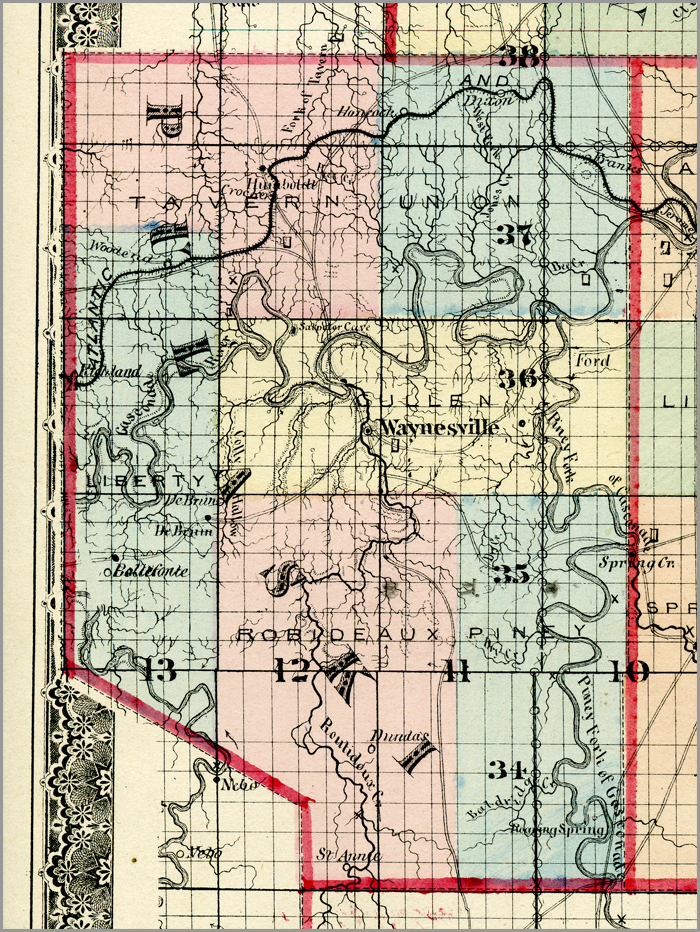Pulaski County, Missouri

- Formed: 1833
- County Population 1860: 3,777
- Slave Population 1860: 56
- Civil War Engagements
-Several small skirmishes
– Suffered constant guerrilla warfare
Image courtesy of Wilson’s Creek National Battlefield
Before white settlement, the Pulaski County, Missouri area was inhabited by the Kickapoo, Osage, Shawnee, and Delaware Native American tribes. The earliest white settler was Josiah Turpin who came to the area in 1813. In 1816, three men with surnames Johnson, Dulle, and Cullen came from Mississippi and settled near a cave in present day Waynesville. They took advantage of the abundant saltpeter in the cave and began to manufacture gunpowder. In 1817, Jesse Ballew/Balleau, Henry Anderson, William Gilaspy/Gillespie, and their families settled in the area from North Carolina.
Pulaski County was originally part of Gasconade County. The earliest settlers had small cabins and farms in the River Valleys, where they raised cattle, pigs, mules, and chickens, hunted rabbits, quail, deer, and turkey, and cultivated wheat, corn, apples, and peaches. They harvested wild honey and carried on trade with the Native American tribes. Located on the Big Piney Fork of the Gasconade River, it provided rich, fertile soil for farmers. Early residents used this soil to grow corn and wheat. The caves in the area also were a natural source of bat guano, which was traded as a fertilizer with a company in St. Louis. Pulaski County also contains abundant lead and iron deposits, though they have never been mined due to difficulty of access.
The county was officially formed in 1833, and included present day Phelps and Laclede Counties. Pulaski County was named after Count Casimir Pulaski, a Polish politician who fought in the Revolutionary War. A commission of men from other counties—James E. Mills of Osage County, William Montgomery of Niangua County, and Thomas J. Marshall of Miller County—named the county seat at Waynesville, one of two main population centers in the county.
Several Pulaski County men fought in the Mexican War in the late 1840s, though they did not stay for long and quickly returned home after arriving in Mexico. When the Civil War began, the majority of the county sympathized with the South because of the large number of slaveholders in the county, although the actual number of slaves was fairly small, 56 individuals. However, a large majority opposed secession. In May 1861, Colonel Franz Sigel of the Union army approached Pulaski County, and many residents fled to Illinois. In June of the next year, Sigel returned to capture Confederate troops. While in the town, the Sigel’s troops also destroyed the town saloon. Sigel left the 13th Missouri State Cavalry in charge, and they built a fort at Waynesville that controlled trade from Rolla to Lebanon. There were no major battles, though troops from both sides consumed most of the resources in the area and Bushwhackers were the source of most of the violence. There were very few military casualties from Pulaski, as less than 500 Pulaski County men fought for either side of the war. Many of those who fled during the war did not return, though a population boom in the late 1860s to the early 1870s, spurred on by railroad construction. Richland and Dixon were established in 1869. A large wave of Swedish immigrants came to the area in 1870 and formed the town of Swedeborg.
 Browse all collections in Pulaski County
Browse all collections in Pulaski County
- Consulted:
- History of Laclede, Camden, Dallas, Webster, Wright, Texas, Pulaski, Phelps, and Dent Counties (Chicago: Godspeed Publishing Company, 1971).
- Pulaski County, 1860 U.S. Federal Census – Slave Schedules [database on-line]. Provo, UT, USA: Ancestry.com Operations Inc, 2004. Original data: United States of America, Bureau of the Census. Eighth Census of the United States, 1860. Washington, D.C.: National Archives and Records Administration, 1860. M653, 1,438 rolls.












